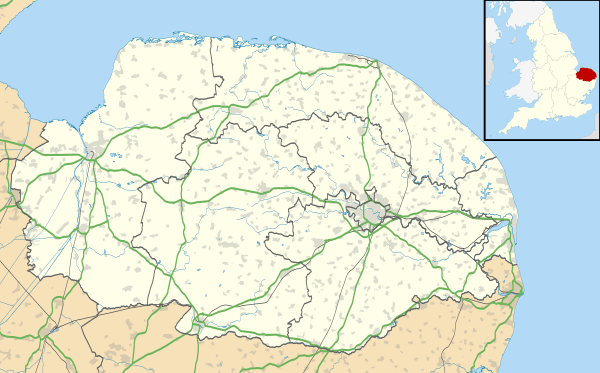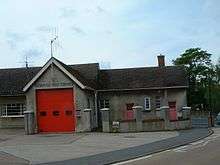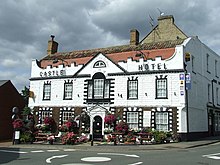Downham Market
Downham Market, sometimes simply referred to as Downham, is a market town and civil parish in Norfolk, England. It lies on the edge of the Fens, on the River Great Ouse, approximately 11 miles south of King's Lynn, 39 miles west of Norwich and 30 miles north of Cambridge.[2]
| Downham Market | |
|---|---|
.jpg) Clock Tower in Downham Market | |
 Downham Market Location within Norfolk | |
| Area | 5.20 km2 (2.01 sq mi) |
| Population | 9,994 (2011 Census)[1] |
| • Density | 1,922/km2 (4,980/sq mi) |
| OS grid reference | TF611032 |
| District | |
| Shire county | |
| Region | |
| Country | England |
| Sovereign state | United Kingdom |
| Post town | DOWNHAM MARKET |
| Postcode district | PE38 |
| Dialling code | 01366 |
| Police | Norfolk |
| Fire | Norfolk |
| Ambulance | East of England |
| UK Parliament | |
The civil parish has an area of 5.2 km² and in the 2011 census had a population of 9,994 in 4,637 households.[3]

It was an agricultural centre, developing as a market for the produce of the Fens with a bridge across the Ouse. During the Middle Ages, it was famed for its butter market and also hosted a notable horse fair. The market is now held Fridays and Saturdays.
Notable buildings in the town include its mediaeval parish church, dedicated to St Edmund, and the Victorian clock tower, constructed in 1878. The town is also known as the place where Charles I hid after the Battle of Naseby. In 2004 the town completed a regeneration project on the Market Place, moving the market to the town hall car park. The decorative town sign depicts the crown and arrows of St Edmund with horses to show the importance of the horse fairs in the town's history.
A heritage centre, Discover Downham, opened in a former fire station in 2016.[4]
Governance
For the purposes of local government, the parish falls within the district of King's Lynn and West Norfolk. The Norfolk County Council electoral division of Downham Market covers a lesser area than that of the parish; the population of this division taken at the 2011 Census was 7,988.[5] The town is part of South West Norfolk parliamentary constituency.
Economy
Historically, Downham Market was an important market centre for the surrounding agricultural area. It incorporated a famous horse fair and weekly livestock and butter markets. There were several maltings in the town supplying the brewing trade in the town at a time when beer was often safer to drink than well water.
Before the arrival of the railway in 1846, the riverside was largely agricultural with warehousing for river transport centred on the Great Ouse at Downham West. With the coming of the railway there was a rapid industrial and residential development into Downham Market.[6]
Jacob Mason Bird built his steam mill by the railway. The mill, now run by Heygates, is still known as Bird’s Mill.[7] Other industries grew too as the railway became the focus for warehousing, the loading of cattle and products, and the building of railway housing.
The Town Hall was also the town's corn exchange, an important building in an agricultural town that supported several corn merchants and windmills. One, Denver Windmill, still survives in the nearby village of Denver.
Today, Downham Market has seen rapid residential development and has become a popular commuter town for Cambridge. The town still hosts a market on Fridays and Saturdays.
Landmarks
War memorial
The town's war memorial stands at the junction of London Road and Church Road. It was dedicated in October 1921 to the dead of World War I. It was paid for by public subscription and built by H. J. Long, a local stonemason. The memorial originally commemorated 73 local servicemen who fell in the First World War with the names of the dead of World War II added later. In 2005, Evelyn Irene Murrell, who died in 1918,[8] a member of the Women’s Royal Air Force, was belatedly added to the list of names. The memorial bears the crown-and-arrows symbol of the town and of the martyred King St Edmund of East Anglia to whom the church is dedicated.
Town clock
The Town Clock, built by William Cunliffe in 1878, is a Grade II listed structure. Made of cast iron, the clock was originally bronzed and relieved on the prominent parts with gold. Later the clock was painted bottle green, and its current black-and-white finish was applied during the 2004 restoration.[9]
Notable buildings

Downham Market is known as the 'Gingerbread Town' because of the characteristic local carrstone used for buildings since medieval times.
St Edmund’s Church is a good example of this and is Downham’s only Grade I listed building. It stands in a dominant position overlooking the flat fenlands to the west. The Church like the town was probably an Anglo-Saxon foundation but rebuilt in the 13th century (Early English period) and extensively altered in the 15th and 16th centuries (Perpendicular and Tudor periods). The roof was originally thatched.
Discover Downham Heritage Centre was formerly the old Fire Station and home of the Fire Chief for over seventy years. It was converted from the cottages of Raven’s Row.
The 17th-Century Priory House is one of the oldest houses in the town, although there is no evidence of a priory in Downham.
The Old Court House located on London Road was where the magistrates dispensed justice in the Clackclose Hundred from 1849. Next to the Court House, the short road leads to Court Gardens on the site of the Union Workhouse, built 1837, demolished 1969. This attractive carrstone building was designed by William Donthorne (1799–1859), one of the founders of what became the Royal Institute of British Architects (RIBA). All that remains are the two gatehouses. Adjacent to the gatehouses is the National School, built 1841, and attended by children at the workhouse.
The Castle Hotel is Grade II listed and features a distinctive battlemented parapet. It is a mainly 18th-Century building, but the core is probably earlier.[10] In the past, visitors stayed here for hunting, shooting and fishing in the local area. The hotel had its own transport to and from railway station, and out on shooting parties. The building is still a hotel and restaurant.[11]
The Town Hall, on the opposite side of the old Market Hill, was built by public subscription in 1887/8. Like many of the surrounding buildings it is constructed from locally made white bricks and carrstone. It was formerly the town’s corn exchange, home of the Urban and Rural District Councils and the centre of the town’s social events.
Opposite the Town Hall is the coaching inn, The Crown Hotel. Just inside the arched entrance are steps leading to a mounting block for horsemen. Before the Court House was built, magistrates met here. In May 1816 it was the scene of riots when the magistrates were besieged by angry, starving agricultural labourers demanding a living wage of two shillings a day and the release of poachers. Two of the Downham rioters, Daniel Harwood and Thomas Thody, were hanged on 31 August 1816.[12]
The 18th-century Dial House, located on Station Road, was once a private school for gentlemen in the 1860s.[13] Its name is derived from the sundial painted high on the wall. Today the building is a bed and breakfast.
Transport
Rail
Downham Market railway station, which serves the town, is on the Fen Line from London to King's Lynn. It opened in 1846. The station has hourly services to London Kings Cross and King's Lynn operated by Great Northern with additional Abellio Greater Anglia services to London Liverpool Street at peak times.
The town signal box is one of five rare examples across the region to have been granted Grade II listed status in 2013. The Department for Culture, Media and Sport listed 26 signal boxes across the country as part of a joint project between Network Rail and English Heritage to secure the nation's railway signalling heritage. Downham's signal box was built in 1881 for the Great Eastern Railway.[14]
Bus
The town is served on Mondays - Saturdays by Lynx route 37 to Southery and King's Lynn.[15] and by less regular "Go to town" services 47, 60 and 61 to Fincham, Three Holes, Swaffham and Kings Lynn.[16] There are no buses serving the town on Sundays.
Road
Downham Market is on the north-south A10 road from London to King's Lynn. The east-west A1122 from Outwell to Swaffham runs south of the town.
River
The River Great Ouse and Great Ouse Relief Channel flows through the Western boundary of the town.
The Great Ouse Relief Channel was made navigable in 2001, when the Environment Agency constructed a lock at Denver to provide access. Moorings are located next to the Station Road bridge.[17] The river is a popular spot for boating and swimming.
Education
There are two primary schools in Downham Market: Hillcrest Primary School and Nelson Academy.
Nelson Academy, situated on Nursery Road, was originally named Clackclose Community Primary School after Clackclose Hundred. The school opened in 1873 on Snape Lane. It was the first primary education academy sponsored by the CWA Academy Trust, founded by the College of West Anglia, in 2014. It is named after Lord Nelson who, according to local folklore, attended his first school in Downham Market.[18]
Downham Market Academy, formerly Downham Market High School, is a secondary school and sixth form with academy status, The academy was launched on 1 July 2013, sponsored by the CWA Academy Trust founded by the College of West Anglia. Teaching is shared between two sites, with the main Bexwell campus housing pupils years 7–11 (ages 11–16) and the Downham Market Academy Sixth Form (formerly Downham Market College) campus offering A-levels to sixth form pupils years 12–13 (ages 16–18).
Downham Preparatory School and Montessori Nursery is a non selective Independent Preparatory School for girls and boys aged 3 months to 13 years. The school was founded by its present owner, Elizabeth Laffeaty-Sharpe, in 1984 for children aged 2 to 5 years.
The Priory Centre holds the Downham Market Library.[19]
Sport and leisure
War Memorial Playing Fields holds a children’s playground, tennis courts and a multi-purpose sports court. A non-league football club, Downham Town F.C., plays at the Memorial Field.
The Willows nature reserve was once one of the town's brickfields.
The Jubilee Community Centre, located on Howdale Road, hosts local Workshops, classes, child-care and community events. The Community Centre has a large field adjacent.
The Downham Market Heritage Centre includes interactive displays focused on local history. The centre includes free wifi, an internet café and research facilities with small library.
Notable residents
- George William Manby (1765–1854), inventor of a lifesaving rocket and the first modern form of fire extinguisher, was educated in the town.
- George Henry Dashwood (1801–1869), antiquary, was born in the town.
- Golding Bird (1814–1854), Fellow of the Royal College of Physicians of London, became an authority on kidney diseases.
- William Hayes Fisher, 1st Baron Downham PC, KStJ (1853–1920), was a Conservative Party politician.
- Father Oswald Baker (1915–2004), controversial Catholic priest, originally at St Dominic, Downham Market and later had his own chapel.
- Jim Russell (1920–2019), former racing driver.
- Patrick Holman (1945–), cricketer, was born in the town.
- Richard Murphy (1958–), political economist.
- Liz Truss (1975–), Conservative MP for South West Norfolk and government minister.
See also
References
- "Town population 2011". Retrieved 26 August 2015.
- Ordnance Survey (1999). OS Explorer Map 236 – King's Lynn, Downham Market & Swaffham. ISBN 0-319-21867-8.
- Office for National Statistics & Norfolk County Council (2001). Census population and household counts for unparished urban areas and all parishes. Retrieved December 2, 2005.
- Bale, David (29 March 2016). "West Norfolk town finally gets its own heritage centre". Retrieved 20 January 2017.
- "Ward population 2011". Retrieved 27 August 2015.
- "Working Life". www.discoverdownham.org.uk. Retrieved 10 August 2020.
- "History of Heygates flours and grains". www.heygates.co.uk. Retrieved 10 August 2020.
- "In Memory of Evelyn Irene Murrell" (PDF).
- "All about our clock". downhamweb. Retrieved 5 August 2020.
- Historic England. "Castle Hotel (Grade II) (1170776)". National Heritage List for England.
- "The Castle Hotel, Downham Market | Beautiful accommodation and dining in West Norfolk". castle-hotel.com. Retrieved 5 August 2020.
- Peacock, A J (1965). Bread Or Blood A study of the agrarian riots in East Anglia: 1816. London: Victor Gollancz. p. 93.
- "Dial House | West Norfolk | Bed and Breakfasts | Go See Norfolk". www.goseenorfolk.com. Retrieved 5 August 2020.
- Historic England. "Downham Market Signal Box (1414022)". National Heritage List for England. Retrieved 20 January 2017.
- "37 | Lynx". www.lynxbus.co.uk. Retrieved 4 August 2020.
- "WISBECH – DOWNHAM MKT – SWAFFHAM via Outwell & Three Hole WELNEY – DOWNHAM MARKET via Outwell, Three Holes 60,61 & 62 | DOWNHAM MARKET – KING'S LYNN via Stowbridge and Magdalen 47" (PDF).
- "The River Great Ouse & Cam". Jones Boatyard. 24 November 2014. Retrieved 5 August 2020.
- "About Us", Nelson Academy. Retrieved 6 September 2014.
External links
| Wikimedia Commons has media related to Downham Market. |
